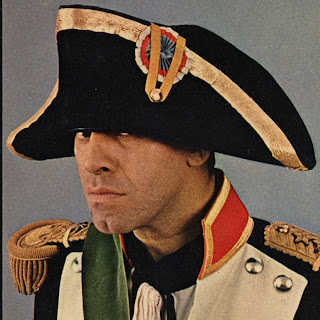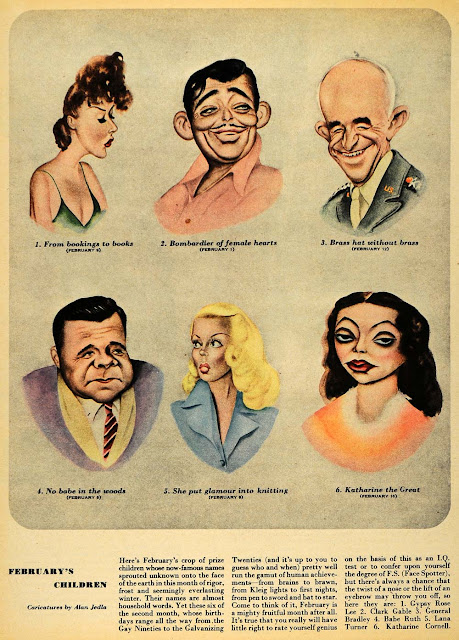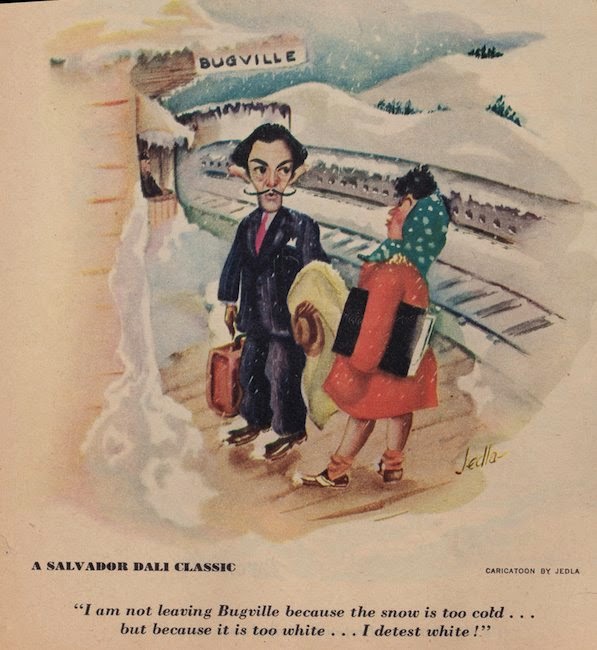 |
| My cover to the caricaturist's quarterly (originally the cover art for "The Wicked Wit of the West" by Irving Brecher) |
This convention is unique, in that that it's a "working convention", the caricaturists sit in the large pavilion and draw (mainly each other) throughout the duration of the convention, their results finally displayed for competition, the winners announced at the awards banquet on the final night.
http://www.caricature.org/
I provided the keynote visual address for the convention :"Old Jewish Comedians and me", as well as a second visual presentation; "Adventures and misadventures", detailing my career high points and low points, and all points in between (making sure there were no children in attendance). The most enjoyable part of the convention for me (aside from the sun, and the beach, and the pool, and the food, and the...) was getting to meet so many talented artists, watching them work and witnessing their amazing results. My thanks again to everyone at ISCA (International Society of Caricature Artists) for being so kind to my wife and I.
Next years guest speaker, the great John Kascht.
 |
| The beautiful Tradewinds resort at St. Pete's Beach (free plug! I expect a room upgrade next time) |
 |
| the always dapper Brit, Steve Hearn, the president of ISCA (with his gorgeous Florida suntan), me, and artist Brent Brown |
 |
| Steve Hearn by Court Jones |
 |
| preparing to begin my keynote presentation. My projected name helped to remind me of exactly who I was. |
After my second presentation, I entertained questions from the ISCA audience. Here are some Highlights. (thanks to Steven Kaufman for transcribing)
Q. (Audience member): When did you decide to be an artist?
A. (DF): When I was a little kid, right off the bat. All I wanted to do was draw, draw faces. I didn’t want to go to school, I didn’t want to go out and play, I didn't want to go to camp, all I wanted to do was draw, read comic books and MAD, and watch TV. I watched Our Gang, The Three Stooges, F-Troop, Popeye cartoons, Superman, Soupy Sales, old horror and comedy movies... That's the only education I was interested in. To me school was a complete waste of time. I knew that then and I still believe it. I still resent being sent to school. And It was always drawing faces, an obsession with ugly faces, to this day. My type of caricature is closer to slight distortion rather than over the top caricature. Sometimes it can be over the top, but I'm more of a 'portrait artist" I suppose. I'm hard to pinpoint. I tend to jump around from caricature, to portraits, to comics, editorial illustration, cartoons...
My dad has made the observation that "Drew always notices the people that nobody else notices", Which is true. Aside from famous and obscure celebrities, I’ve been drawn to draw elevator operators, waiters, bus drivers, cab drivers, gas station attendants, comic shop clerks...
... people no one would think to draw or pay tribute to.
... people no one would think to draw or pay tribute to.
Q. (Tom Richmond): What absolutely amazes me about what you do – you’re an illustrator’s illustrator. A lot of theses guys here love to do faces, but I like how your work has a narrative aspect to it. You bring that in along with the beautiful drawings.
Another thing - most illustrators, when they do work for magazines work 150% to print size or bigger - so it gets nice and tight when it gets shrunk down. It makes you look like you really know what you’re doing. You work at print-size, so what we see printed in a magazine is exactly the size you worked at – with the incredible detail you give it.
A. (DF): I got into that early, when I was doing stipple. The dots, the thousands of dots. With stipple work especially, you had to be just an inch from the page while you're doing it. These days I work the brush. Some color pencil, mostly just water color. All on paper. I don’t work on a computer. I just do it the old-fashioned way like I’ve worked for the last 30 years. But like Tom, I like doing the small details. I love getting into those panels and focusing on the tiny background details that most other artists wouldn't think were important, the "chicken fat" as Harvey Kurtzman called it.
I’ve heard from art directors over the years who’ve said they’ve kind of grown up with my stuff, especially my comic strips. They knew it was just different from the kind of things they were seeing. I think a lot of them appreciated seeing the effort I was putting into it, especially when I was doing the stipple. Every little detail I think about.
Putting the extra effort in, like the great Tom Richmond does, people really appreciate that, I’ve found.
Q. (Audience member): Did you take classes?
A. (DF): I went to The School of Visual Arts in New York, where a lot of great caricaturists and cartoonists taught at the time. Harvey Kurtzman, taught there. Will Eisner, Art Spiegelman, Stan Mack, Edward Sorel, Arnold Roth. Not all of them great teachers but still It was kind of a golden era.
Q. (Audience member): Do you think the quality of MAD’s gone down since William M. Gaines died?
A. (DF): Well.. I think the quality went way UP... because they hired me as an artist soon after Bill Gaines died! (laughter from audience) It went sky high after that. I'm just not sure who reads MAD now. Kids, do they really buy magazines or comics anymore? It now comes out just six times a year... and there’s still some terrific work in there. Tom Richmond is a regular – his stuff is great. He’s the new Mort Drucker. Hermann Mejia is terrific. The computer generated covers by Mark Fredricson are first rate. And many of the old time idiots still contribute like Sergio and Al Jaffee. There’s still some great stuff they run in there, art wise and the writing too, but I don't think it's same as it once was – it’s not as essential as it once was. Jon Stewart is instant, MAD magazine isn't, although their blog is.
Q. (Dave "Bippy" Boyer): In your Old Jewish Comedians books, your approach celebrates these seniors. I didn’t see anything acidic in there, you’re really celebrating these guys.
A. (DF): I’ve gotten criticized for my liver spots…but I’m glad you appreciate that. I’d like to think I am celebrating them – not making fun of them. I wanted in my way to pay tribute to them, honor them. Most of them I loved and like I said, many of the older comedians like The Three Stooges, The Marx Brothers, Jerry Lewis, Sid Caesar, Jack Benny, Zero Mostel, Phil Silvers – so many were Jewish. Or happen to be Jewish. By simple process of elimination, most of my favorite comedians happen to be Jewish comedians, but not across the board. I love Ernie Kovacs for instance. Also Buster Keaton, Bob Hope, Lou Costello, Jackie Gleason, Jimmy Kimmel...
I like to think when comedians aren’t Jewish, if they’re really funny, they should be Jewish. There's a story of George Burns and Groucho sitting together, enjoying Bill Cosby doing a routine on TV. At one point Burns turns to Groucho and says "Too bad he's not Jewish". There’s a guy in my new book, Stan Freberg. Turns out he’s not Jewish. I made a mistake, should have researched a little more. I assumed he was Jewish because his name was "Freberg". Who knew? My excuse was he's so brilliant, clever and funny, I just naturally assumed he was Jewish.
I like to think when comedians aren’t Jewish, if they’re really funny, they should be Jewish. There's a story of George Burns and Groucho sitting together, enjoying Bill Cosby doing a routine on TV. At one point Burns turns to Groucho and says "Too bad he's not Jewish". There’s a guy in my new book, Stan Freberg. Turns out he’s not Jewish. I made a mistake, should have researched a little more. I assumed he was Jewish because his name was "Freberg". Who knew? My excuse was he's so brilliant, clever and funny, I just naturally assumed he was Jewish.
Q. (Audience member): Do you have a sense of where the computer will take things? What do you think is going to happen in two to five years?
A. (DF): I can’t predict. When young people say, ‘how do I get into it?’ – I say "are you sure you really want to get into it?" Magazine illustration is in flux. Entertainment Weekly hardly runs any illustrations anymore. Most of the work I do now is personal work – for books and commissions. I’ve kind of come full circle. Originally I was doing personal work about obscure actors and celebrities – work for myself and my friends. I didn’t even think of getting published. And then little by little, I segued into commercial illustration. I’m now doing Old Jewish Comedians and Side Show Freaks – work that I’m passionate about rather than thinking about pleasing an art director…
I still do lots of editorial work but it’s just not the same as it was. I pick and choose now more often than before. I’ve talked to many other illustrators – and they’re sitting around and waiting for the phone to ring. Maybe I’ve been more fortunate because I’ve been around and made some noise and people know what to expect from me. It’s not like I’m introducing myself as a new guy which I think would be hard. Not impossible.
Q. (Audience member): How do you find your references? Is it hard to find photos of these guys – they’re not in the public eye anymore.
A. (DF): I’d kept files over the years, collected various photos, since I was a kid really. Especially the comedians, but whatever looks interesting or worth saving. Not just standard photographs, smiling full-face resume photographs, which I hate. I always went out of my way to collect side views of people, profiles, celebrities or every day folks looking down or away from the camera. I love just getting half of a person’s face… But these days you can just google anything and everything comes up. It’s pretty amazing.
Q. (Eve Myles): Your Frank Sinatra portrait has so many decades in it – it has some young, some middle, some old. It’s just phenomenal, don’t you think?
A. (DF): Well... I can’t say? I... don’t like it. I don’t think it’s very good. Don’t ask me...
I drew Sinatra for a New York Observer tribute to him by Peter Bogdanovich and Gay Talese the weekend after he died. He died on a Friday, so I worked on Saturday and Sunday with his music playing in the background. I love Frank Sinatra, but I wasn’t in tears, yet it was very emotional to work on that piece. I wanted to capture his cockiness and also his sensitivity. That’s one aspect I love about him and his music – he can convey being cocky almost at the same time as being sensitive. I wanted the portrait to somehow portray that. The tilt of the hat, the raised shoulder, the drink and cigarette, conveys the famous Sinatra arrogance. Then the uncertainty of the hand in pocket – a little bit of insecurity there, the other lowered shoulder, and the "please like me" expression hopefully conveying the other side.
I drew Sinatra for a New York Observer tribute to him by Peter Bogdanovich and Gay Talese the weekend after he died. He died on a Friday, so I worked on Saturday and Sunday with his music playing in the background. I love Frank Sinatra, but I wasn’t in tears, yet it was very emotional to work on that piece. I wanted to capture his cockiness and also his sensitivity. That’s one aspect I love about him and his music – he can convey being cocky almost at the same time as being sensitive. I wanted the portrait to somehow portray that. The tilt of the hat, the raised shoulder, the drink and cigarette, conveys the famous Sinatra arrogance. Then the uncertainty of the hand in pocket – a little bit of insecurity there, the other lowered shoulder, and the "please like me" expression hopefully conveying the other side.
Q. (Audience member): Are you still evolving your techniques?
A. (DF): I like the word “evolving.” I evolved from the stipple style to phasing that out slowly to become a watercolor artist. I was nervous about it because I sort of established myself as a stipple artist. I was never necessarily a fan of stipple but it worked for me because it slowed me down. When I was younger I used to work way too fast. As an exercise I started working in stipple – it served the work I was doing. I wanted a realistic look early on with the comic strips - almost photo-realistic, noir-like. A retro kind of look, almost like a secret grainy photo.
Little by little I phased that out without art directors even noticing. Only one guy did, an editor at MAD. It evolved from the stipple to the water color style. Artists should evolve. Don’t get stuck just doing one thing. At least that's how I feel.
Q. (Audience member): Isn’t water color really unforgiving?
A. (DF): Yup, true, It can be heart-breaking at times. Sometimes I think of switching over to oils like Dan Adel or Roberto Parada among others, I love their work, but you got to deal with these fumes and you got to wait for it to dry. It can take days and days. And the mess. Watercolor dries instantaneously. It’s over, you’re finished. run your tray and brushes under the sink. Done. And it goes right into the scanner… I don’t think I'd like working on canvas, I just like working on paper. I'm set in my ways.
Q. (Audience member): Do you see yourself ever going digital?
A. (DF): No. (laughter from audience)
Q. (Audience member): Is there anything you do stylistically to make it yours? Your trademark?
A. (DF): Yes, my trademark is liver spots. Liver spots are my "Ninas". That’ll be my legacy. The guy who drew the liver spots. My obit will start off; "Drew Friedman, who popularized Liver Spots..."
Q. (Audience member): Do any of your subjects try to buy the original work?
A. (DF): Sure, a few. Howard Stern has bought some, the guy who played the Soup Nazi on "Seinfeld", the film producer Harvey Weinstein, Elton John, Jerry Lewis, among others.
There are certain celebrities who, any time they’re drawn, they’ll purchase the piece. Obviously many if not all have large egos. I've heard the comedian Richard Lewis has one room in his home filled with drawings and paintings of himself.
A story I love concerns Al Hirschfeld and Liberace. Hirschfeld did a cover for Collier's magazine of Liberace in the mid-50’s – a beautiful color painting of him sitting at the piano beaming at the reader. So Liberace’s people first contacted Colliers to obtain the art, who informed them the art was returned to Mr. Hirschfeld. They then contacted Hirschfeld and pronounced: "Liberace has collected paintings of himself created by many of the world's GREAT artists, all of whom had requested no compensation, but he also loves your piece and asks that you to send it to him to hang in his home". Al responded: “Why certainly, I’ll send my painting of Liberace for him to hang on his wall alongside the work created by all the great art titans, and in return I would like you to send me Liberace, so I can hang him on my wall.” (laughter)
There are certain celebrities who, any time they’re drawn, they’ll purchase the piece. Obviously many if not all have large egos. I've heard the comedian Richard Lewis has one room in his home filled with drawings and paintings of himself.
A story I love concerns Al Hirschfeld and Liberace. Hirschfeld did a cover for Collier's magazine of Liberace in the mid-50’s – a beautiful color painting of him sitting at the piano beaming at the reader. So Liberace’s people first contacted Colliers to obtain the art, who informed them the art was returned to Mr. Hirschfeld. They then contacted Hirschfeld and pronounced: "Liberace has collected paintings of himself created by many of the world's GREAT artists, all of whom had requested no compensation, but he also loves your piece and asks that you to send it to him to hang in his home". Al responded: “Why certainly, I’ll send my painting of Liberace for him to hang on his wall alongside the work created by all the great art titans, and in return I would like you to send me Liberace, so I can hang him on my wall.” (laughter)
 |
| Liberace by Hirschfeld drawing in the pavilion |
 |
| Talking about drawing Howard Stern with artist Glenn Ferguson creating sculptures. I particularly liked the Trump hair and Steve Jobs |
 |
| Some of the caricatures created at the convention, on display and ready to be voted on. with the world's tallest caricaturist (6/9) |
 |
| with the legend; Dave "Bippy" Boyer |
http://www.amazon.com/Mad-Art-Caricature-Serious-Drawing/dp/098357670X/ref=sr_1_1?s=books&ie=UTF8&qid=1324913077&sr=1-1
 |
| This was my first runner up, drawn by Dan Almariei |
 |
| and my pick for best in show, by 23 year old Marcus Sakoda, a caricature of a fellow conventioneer (OK, I like profiles) |
 |
| The awards banquet on the final night. The food wasn't bad either! |
 |
| and a final view from our room (photo by my wife Kathy) |
Special thanks to ISCA president Steve Hearn and all the terrific ISCA organizers. Also thanks to Rick Wright and all the other ISCA members who's photos I borrowed for this blog post.







































































.%2BJedla%3ACass%2BDaley.jpg)
















